Our Certified Arborists are Kansas City’s tree preservation experts. We provide consulting and planning services as well as solutions which are tailored to the trees needs and the client’s goals.
As specialists in the care of individual trees, K.C. Arborist performs services that protect and preserve both mature and young trees. New cutting-edge equipment enables K.C. Arborist to preserve mature trees enabling customers to preserve the beauty of our urban environment.
For more information on Emerald Ash Borer Tree Preservation, CLICK HERE
Soil Compaction
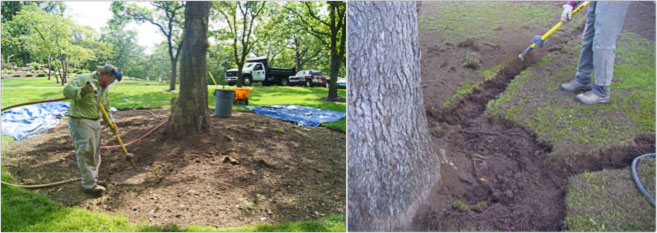
Breaking up compaction and aerating the soil in a hub and spoke pattern using the Air Spade.
When the root zone of a tree lives in compacted soil, the rest of the tree is negatively affected. Without the proper flow of nutrients and water moving through the root system, trees become stressed. In turn, that stress opens trees up to insect and disease problems that they would otherwise be able to fight off. When the nutrient deficiency is great enough, that can be enough to damage a tree on its own. Compaction can be the result of a construction project or simply everyday vehicle or foot traffic over the roots. Also, some soil types (like Kansas City’s heavy-clay soils) are more prone to compaction than others.
Girdling Roots
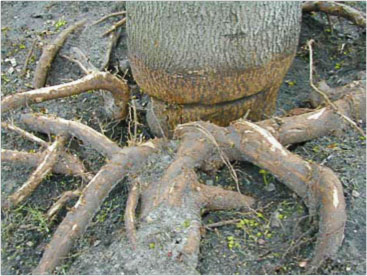
Trees are commonly planted too deep or have excess soil or mulch covering the root flares resulting in decline, girdling root formation, root rot and even tree death. Rope or twine left around the roots when planted is another common cause of girdling root formation.
Performing a Root Collar Excavation can reveal girdling roots. Left uncorrected, these circling roots often damage the stability of a tree’s root system and restrict the flow of nutrients to the trunk.
Girdling roots grow around the main stem of the tree and cut off or restrict the movement of water, plant nutrients and stored food reserves. A Root Collar Excavation is the process of removing excess soil from the top of root flares and around the trunks of trees.
Your certified arborist will identify indications of girdling roots, including:
- No visible trunk flare at soil surface
- Thin or sparse canopy
- Off-colored leaves
- Early fall color and leaf drop
- Trunk with recessed or flat areas
Root Damage
Using Cambistat to help trees with Injured Tree Roots
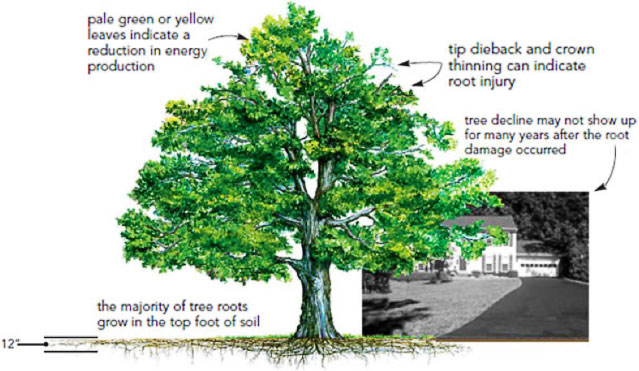
The Best Strategy for Managing Root Damage Is Avoidance
How close can root damaging activity come to a tree without causing injury? The simple answer is the farther away it stays the better. If possible, avoid damage within the drip line of the tree. The more area you can protect the less impact on your tree.
Before root damage occurs. Cambistat is best used before construction activity. Cambistat puts the tree in a more conservative mode by reducing water needs, slowing top growth and redirecting energy to fibrous root growth. A tree with a bottom-heavy balance between the roots and crown will have greater stability during the stress and a stronger likelihood of long-term survival.
Damage that has already occurred. If root damage has already occurred, try to stabilize the tree and prevent decline. Not all trees may be savable if the damage is severe, and there is significant decline. Cambistat should be used in conjunction with other cultural practices to get the best results.
Benefits of Cambistat for Urban Trees
Cambistat is a soil applied product that is absorbed through the roots. Cambistat gently slows the growth of trees, allowing the tree to redirect some of its energy from canopy growth to defense chemicals, fibrous root production, and other uses. The resulting reallocation of energy makes your tree healthier and more durable.
Drought is a major cause of tree death and decline in the urban landscape. Research shows Cambistat increases drought resistance by helping the tree reduce water losses during dry, hot periods.
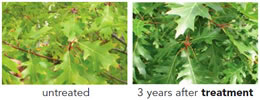
Cambistat changes some important physical traits of leaves. Leaves of treated trees tend to be greener (higher concentrations of chlorophyll) than untreated and have an enhanced protective barrier (thicker leaf surface and denser surface hairs).
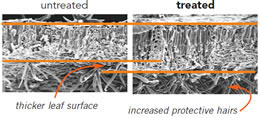
Research has shown Cambistat increases fine root density in trees.
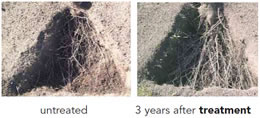
An Integrated Approach
When caring for urban trees it is important to make a thorough evaluation of the site to accurately diagnose all stressing agents and tailor your recommendation to the specific circumstances. These must be dealt with so that your tree can live to its fullest potential.
To schedule a site visit to discuss preserving your trees contact us.








